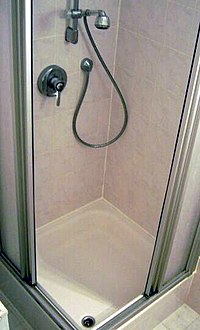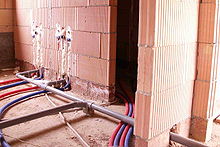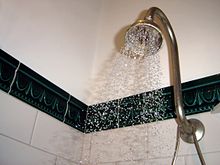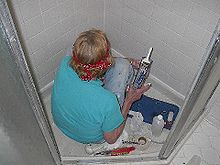Shower: Difference between revisions
Enthusiast01 (talk | contribs) mNo edit summary |
Enthusiast01 (talk | contribs) |
||
| Line 26: | Line 26: | ||
[[File:Outdoor Poolside Shower.jpg|thumb|left|Many public swimming areas offer poolside showers]] |
[[File:Outdoor Poolside Shower.jpg|thumb|left|Many public swimming areas offer poolside showers]] |
||
=== Domestic === |
=== Domestic === |
||
Domestic showers are most commonly stall showers or showers over a bathtub. A stall shower is a dedicated shower area which uses a glass door to contain water |
Domestic showers are most commonly stall showers or showers over a bathtub. A stall shower is a dedicated shower area which uses a glass door to contain water spray. The shower over a bathtub saves bathroom space and enables the area to be used for either a bath or a shower and commonly uses a sliding shower curtain to contain the water spray. Showers may also be in a wet room, in which there is no contained shower area, or in a dedicated shower room, which does not require containment of water spray. Most domestic showers have a single overhead shower head, which may be adjustable. |
||
=== Public === |
=== Public === |
||
Revision as of 22:13, 10 June 2012


A shower (or shower-bath, walk-in shower, steam shower) is a place in which a person bathes under a spray of water.[1] A shower uses less water than a bath: 80 litres on average for a shower compared to 150 litres for a bath.
History
The original showers were neither indoor structures nor man-made, but were common natural formations: waterfalls.[2] The falling water rinsed the bathers completely clean and was more efficient than bathing in a traditional basin, which required manual transport of both fresh and waste water. Ancient people began to reproduce these natural phenomena by pouring jugs of water, often very cold, over themselves after washing. There has been evidence of early upper class Egyptian and Mesopotamians having indoor shower rooms where servants would bathe them in the privacy of their own homes.[3] However, these were rudimentary by modern standards, having rudimentary drainage systems and water was carried, not pumped, into the room.
The ancient Greeks were first peoples to have showers. Their aqueducts and sewage systems made of lead pipes allowed water to be pumped both into and out of large communal shower rooms used by elites and common citizens alike.[4] These rooms have been discovered at the site of the city Pergamum and can also be found represented in pottery of the era. The depictions are very similar to modern locker room shower, and even included bars to hang up clothing.[3] The ancient Romans also followed this convention; their famous bathhouses can be found all around the Mediterranean and as far out as modern day England. The Romans not only had these showers, but also believed in bathing multiple times a week, if not every day. After the fall of the Roman Empire and the rise of Christianity, practising what is today considered good hygiene became a religious taboo and was abandoned almost completely from the late Middle Ages until the Victorian era.[5]
The advanced water and sewage systems developed by the Greeks and Romans quickly broke down and fell out of use after the fall of their empires. It was not until the 19th century that a system nearly as complex or reliable as the Greek and Roman sewers was rebuilt. The first showers in the modern era were self-contained units where water could be reused several times.[6] In the early 19th century (probably around 1810, though there is some contradiction among sources), the English Regency Shower was anonymously invented.[2] The original design was over 10 feet (3 m) tall, and was made of several metal pipes painted to look like bamboo. On the top of the unit was a basin connected to these pipes. The water was pumped through a nozzle and over the occupant's shoulders before being collected and pumped back into the basin. This prototype went through several renovations including hand pumped models, models with several sprayers, and those with interchangeable nozzles. The reinvention of reliable indoor plumbing around 1850[7] allowed the free-standing showers to be connected to a running water source, making them easier to use.
The first modern shower was used in 1860 by the French army, as an economic hygiene measure, which installed communal showers in barracks. The system was adopted in 1872 by François Merry Delabost, a French doctor and inventor, who when he was surgeon-general in Bonne Nouvelle prison in Rouen, France replaced individual baths with mandatory communal showers for use by prisoners, arguing that they were more economic and hygienic.[8] The French system of communal showers was adopted by other armies, the first being that of Prussia in 1879, and by prisons in other jurisdictions. They were also adopted by boarding schools, before being installed in public bathhouses. The first shower in a public bathhouse was in 1887 in Vienna, Austria. In France, publc bathhouses and showers were established by Charles Cazalet, firstly in Bordeaux in 1893 and then in Paris in 1899.[9]
The increase in access to heated water made bathing more comfortable and popular. Even with the new improvements in their design, the shower remained less popular than the bath in industrialised countries until the second half of the 20th century.[citation needed]
Types of showers

Domestic
Domestic showers are most commonly stall showers or showers over a bathtub. A stall shower is a dedicated shower area which uses a glass door to contain water spray. The shower over a bathtub saves bathroom space and enables the area to be used for either a bath or a shower and commonly uses a sliding shower curtain to contain the water spray. Showers may also be in a wet room, in which there is no contained shower area, or in a dedicated shower room, which does not require containment of water spray. Most domestic showers have a single overhead shower head, which may be adjustable.
Public
Many modern athletic and aquatic facilities provide showers for use by patrons, commonly in sex segregated changing rooms. These can be in the form of individual stalls shielded by curtains or a door or communal shower rooms. The latter are generally large open rooms with any number of shower heads installed either directly into the walls or on posts throughout the shower area.
Military forces around the world set up field showers to enable the washing away of dangerous residue from modern weapons such as caustic chemicals, deadly biological agents, and radioactive materials, which can harm forces on both sides of a conflict.[10]
Other types of showers

- Air shower: a type of bathing where high pressure air is used to blow off excess dust particles from cleanroom personnel.
- Electric shower: a shower stall device to locally heat shower water with electrical power.
- Emergency showers are installed in laboratories and other facilities that use hazardous chemicals, and are required by law in the United States.[11] Emergency showers are designed to deluge continuously at around 30–60 gallons per minute[12] (114–227 liters per minute) for at least 15 minutes,[13] and should be located at most 10 seconds away from potential users.[14]
- Graham shower: any type of shower taken in limited environment where normal shower facilities do not exist (e.g., under a rain-filled gutter, under a spigot )
- Navy shower: a method of showering that allows for significant conservation of water and energy.
- Power shower: a shower stall device to locally increase the water pressure available to the shower head by means of an electric pump.
- Roman shower: a shower that does not use a door or curtain.
- Steam shower: a type of bathing where a humidifying steam generator produces steam that is dispersed around a person's body.
- Vichy shower: a shower where large quantities of warm water are poured over a spa patron while the user lies within a shallow (wet) bed, similar to a massage table, but with drainage for the water.
Scottish shower
A Scottish shower consists in alternating application of hot and cold water during a shower session. In the most reduced form, it may consist only of one alternation, that is, applying cold water after a usual hot water shower. It is thought that the alternation of heat and cold improves blood circulation, that is beneficial for instance in rheumatic disorders. The application of cold after heat is well documented in the sauna article section: Health risks and benefits/with cold exposure.
Use
Shower usage in the latter half of the 20th century has skyrocketed. Personal hygiene became a primary concern, and bathing every day or multiple times a day is common among Western cultures.[6] Showering is generally faster than bathing and can use less water.[15] This quick and efficient concept explains its popularity as it fits in with the fast-paced lifestyles of modern people. In addition, showering, as opposed to taking a bath, is recommended for older people because it reduces the risk of injury related to falling.[16]
Cultural significance
Showering is mostly part of a daily routine primarily to promote cleanliness and prevent odour, disease and infection. Advances in science and medicine in the 19th century began to realize the benefit of regular bathing to an individual's health. As a result, most modern cultures encourage a daily personal hygiene regimen. Showering has also developed the reputation as a relaxing and generally therapeutic activity.[6]
Structure and design
Designs for shower facilities vary by location and purpose. There are free-standing showers, but also showers which are integrated into a bathtub. Showers are separated from the surrounding area through watertight curtains (shower curtain), sliding doors, or folding doors, in order to protect the space from spraying water. Showers with a level entry wet room are becoming very popular, especially due to improvements in waterproofing systems and prefabricated components.
Places such as a swimming pool, a locker room, or a military facility, have multiple showers. There may be communal shower rooms without divisions, or shower stalls (typically open at the top.)
Types of showers
There are many types of showers that can be installed. These include, complete shower units which are all encompassing showers that include the pan, walls, and often the shower head, as well and pieced together units in which the pan, shower head, and doors are purchased separately. Each type of shower poses different installation issues.
Installation

Though the installation requirements of each of shower will differ, in general the installation of a shower requires the laying of several water transportation pipes, including a pipe for hot water and for cold water, and a drainage pipe.
It is important that the wet areas of a bathroom be waterproof, and multiple layers of waterproofing can be employed. Grout is used to fill gaps between tiles, but grout and tile setting materials are generally porous. Tiles are generally waterproof. Thus small mosaic tiles offer less of a defense than large format tiles. Sub-tile waterproofing is important when tiles are being used. Best practice requires a waterproofing material to cover the walls and floor of the shower area that are then covered with tile, or in some countries with a sheet material like vinyl.
Shower head


A shower head is a perforated nozzle that distributes water over a large solid angle at point of use, generally overhead of the bather. A shower uses less water than full immersion in a bath. Some shower heads can be adjusted to spray different patterns of water, such as massage, gentle spray, strong spray, and intermittent pulse or combination modes. Hard water may result in calcium and magnesium deposits clogging the head, reducing the flow and changing the spray pattern. For descaling, various acidic chemicals or brushes can be used or some heads have rubber-like jets that can be manually descaled. A homemade remedy is to immerse it in a solution of water and vinegar for a while, since the vinegar is able to dissolve limescale..
Some governments around the world set standards for water usage and regulate shower heads. For example, in the United States, residential and most commercial shower heads must flow no more than 9.5 liters per minute (2.5 gallons per minute) per the Department of Energy ruling 10 CFR 430. Low flow shower heads, less than or equal 7.6 liters per minute (2.0 gallon per minute), can use water more efficiently by aerating the water stream, altering nozzles through advanced flow principles or by high speed oscillation of the spray stream. USEPA administers a voluntary water saving program, WaterSense, which can certify low flow shower heads.
Shower curtain
Shower curtains are curtains used in bathtubs with a shower or shower enclosures. They are usually made from vinyl, cloth or plastic. The shower curtain has two main purposes: to provide privacy and to prevent water from flooding or spraying outside the shower area. Shower curtains usually surround the bath inside the tub or shower area, and are held up with railings or curtain rods on the ceiling. To accommodate the different types of bathtub shapes, railings can come in different sizes and are flexible in their design. Some people use two shower curtains: one that is inside the tub, which is mainly functional or decorative as well, and an outer shower curtain, which is purely decorative.
Shower door
Shower doors are doors used in bathrooms that help keep water inside a shower or bathtub and are alternatives to shower curtains. They are available in many different styles such as framed or frameless, sliding or swing. They are usually constructed of aluminum, clear glass, plexi-glass or tempered glass. Shower doors can come in many different hardware finishes and glass patterns that can match other bathroom hardware such as faucets and shower heads. There are also shower doors that are in a neo angle design for use on shower pans that have the neo design as well. The design of the shower pan is extremely important as the shower door must be the type required for the pan in order to work.
Wet room

A wet room is a shower within a bathroom with a barrier-free floor, level with its surroundings. Structurally, a wet room requires a gradient or slope, an outlet hole, and a foul air trap connecting the floor to the waste pipes. In building a wet room it is easier to build the slope all in the one direction. This allows for larger format tile and fewer grout joints but a channel drain is needed instead of a round or square drain.
Drainage
It is a good idea to have a fail safe drain in the bathroom outside of the wet areas. In Australia and some European countries, but not in the United Kingdom or North America, plumbing codes require this second emergency drain.
Equipment used in showers
- Pressure balanced valve, a device to provide constant shower water pressure and prevent temperature fluctuations.
- Shower cap, a cap worn while showering or bathing, to protect hair from becoming wet.
- Shower radio, a radio that is waterproofed to allow it to be used in a bathroom or other wet environment.
- Sunshower, a device to locally heat shower water with solar power.
- Soap
- Shampoo
- Washing mitt, a tool for applying soap to the body.
- Water heat recycling units to reclaim much of the waste water's heat and recycle it to the shower head and minimize heat lost to the drain
See also
References
- ^ OUP 2009, p. 772. Shower, def 3.
- ^ a b "The Stand-Up Bath". theplumber.com. Retrieved 05 December 2010.
{{cite web}}: Check date values in:|accessdate=(help) - ^ a b James & Thorpe 1995, p. [page needed].
- ^ Humphrey, Olsen & Sherwood 1998, p. [page needed].
- ^ McNeil 1990, p. [page needed].
- ^ a b c Shove 2004, p. [page needed].
- ^ "History of Plumbing in America". Plumbing & Mechanical magazine. 1987. ISSN 8750-6041. Retrieved 6 January 2011.
by 1845, the installation of sanitary sewers began to pay off ... In 1874, ... an unknown plumber solved the problem of venting.
{{cite journal}}: Unknown parameter|month=ignored (help) - ^ Hervé Dajon, La douche, une invention d’un médecin des prisons, le docteur Merry Delabost, Criminocorpus, 2010 Online text - in French
- ^ Dr Feltgen, Le Dr Merry Delabost, inventeur de la douche ?, Groupe Histoire des Hôpitaux de Rouen, 2000 (Template:Pdf on line text - in French)
- ^ Jones 2004.
- ^ "1910.151: Occupational Safety and Health Standards — Medical services and first aid". Regulations (Standards - 29 CFR). Occupational Safety and Health Administration. 18 June 1998. Retrieved 1 June 2010.
- ^ Mayer 1995, p. 155.
- ^ Vincoli 2000, p. 343.
- ^ Brauer 2006, p. 533.
- ^ "Shower vs. Bath". Consumer Energy Center. California Energy Commission. Retrieved 5 December 2010.
- ^ Mullick 2005.
Citations
- Books
- Brauer, Roger L B (2006). "Personal protective equipment". Safety and health for engineers (2nd ed.). John Wiley and Sons. ISBN 978-0-471-29189-3.
{{cite book}}: Invalid|ref=harv(help) - Humphrey, John W; Olsen, John P; Sherwood, Andrew N (1998). Greek and Roman Technology: A Sourcebook. New York: Routledge. ISBN 978-0-415-06136-0.
{{cite book}}: Invalid|ref=harv(help) - James, Peter; Thorpe, Nick (1995). Ancient Inventions. New York: Ballantine. ISBN 978-0-345-40102-1.
{{cite book}}: Invalid|ref=harv(help) - Mayer, Leonard (1995). "Emergency systems". Design and planning of research and clinical laboratory facilities. John Wiley and Sons. ISBN 978-0-471-30623-8.
{{cite book}}: Invalid|ref=harv(help) - McNeil, Ian, ed. (1990). An Encyclopaedia of the History of Technology. New York: Routledge. ISBN 978-0-415-01306-2.
{{cite encyclopedia}}: Invalid|ref=harv(help); Missing or empty|title=(help) - Oxford University Press, ed. (2009). Oxford New Desk Dictionary and Thesaurus (3rd ed.). Berkley. ISBN 978-0-425-22862-3.
{{cite encyclopedia}}: Missing or empty|title=(help) - Shove, Elizabeth (2004). Comfort, Cleanliness and Convenience The Social Organization of Normality (New Technologies/New Cultures). New York: Berg. ISBN 978-1-85973-630-2.
{{cite book}}: Invalid|ref=harv(help) - Vincoli, Jeffrey W (2000). Lewis' dictionary of occupational and environmental safety and health. CRC Press. ISBN 978-1-56670-399-4.
{{cite book}}: Invalid|ref=harv(help)
- Web pages
- Jones, Jerry (29 October 2004). "Decontamination shower system revamped". Reporter. Nashville, TN: Vanderbilt University Medical Center. Retrieved 5 December 2010.
{{cite web}}: Invalid|ref=harv(help) - Mullick, Abir (2005). "Bathing for Older people with Disabilities". UB School of Architecture and Planning. Retrieved 5 December 2010.
{{cite web}}: Invalid|ref=harv(help)
